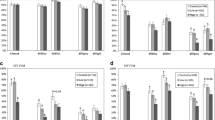Abstract
Objective: We analyzed retrospectively the relevance of 4 years of quality control on homemade culture medium with the mouse IVF and zygote bioassay.
Design: In vitro or in vivo fertilized mouse oocytes were cultured in each batch of medium. Two-cell-stage and expanded blastocyst development was recorded for each batch of medium. Data on fertilization and embryo quality obtained in human in vitro fertilization were recorded for each batch. IVF treatment cycles for male infertility and cycles with sperm microinjection were excluded.
Results: Human oocyte fertilization dropped from 60 to 54%, respectively, from 57 to 41% in a significant way (P<0.05 resp. P<0.01) and the human mean embryo score decreased from 4.17±1.21 to 3.69±1.06 (P<0.05) when media were used with a low two-cell-stage development (≤75%) for the mouse zygote or mouse IVF bioassay. The pregnancy rate was not affected.
Conclusions: Media with high scores in mouse bioassays show higher fertilization rates and better embryo quality when used for human IVF.
Similar content being viewed by others
References
Critchlow J, Matson P, Newman M, Horne G, Troup S, Lieberman A: Quality control in an in-vitro fertilization laboratory: Use of human sperm survival studies. Hum Reprod 1989;4:545–549
Bavister B, Andrews J: A rapid sperm motility bioassay for quality control testing of water and culture media. J Vitro Fert Embryo Transfer 1988;5:67–74
Reed M, Petters R: An evaluation of hamster, rat, and mouse sperm cell motility in media formulated in media with water of different qualities. J Vitro Fert Embry Transfer 1991;8:41–47
Ackerman S, Swanson R, Stokes G, Veeck L: Culture of mouse preimplantation embryos as a quality control assay for human in vitro fertilization. Gamete Res 1984;9:145–152
Bavister B: A consistently successful procedure for in vitro fertilization of golden hamster eggs. Gamete Res 1989;23:139–158
Davidson A, Vermesh M, Lobo R, Paulson R: Mouse embryo culture as quality control for human in vitro fertilization: The one-cell versus the two-cell model. Fertil Steril 1988;49:516–521
George M, Doe B: The influence of handling procedures during mouse oocyte and embryo recovery on viability and subsequent development in vitro. J Vitro Fert Embryo Transfer 1989;6:69–72
Scott L, Sundaram S, Smith S: The relevance and use of mouse embryo bioassays for quality control in an assisted reproductive technology program. Fertil Steril 1993;60:559–568
Hogan B, Constantini F, Lacy E: Manipulating the Mouse Embryo: A Laboratory Manual. Cold Spring Harbor, NY, Cold Spring Harbor Laboratory, 1986
Englert Y, Van den Bergh M, Rodesch C, Vandervorst P, Berberoglugil P, Laruelle C, Biramane J, Gervy C, Schwers J: Nouveau programme de fécondation in vitro à l'hôpital Erasme: premiers résultats et aspects originaux. Rev Med Brux 1991;12:305–314
Puissant F, Van Rysselberge M, Barlow P, Deweze J, Leroy F: Embryo scoring as a prognostic tool in IVF treatment. Hum Reprod 1987;2:705–708
Gerrity M: Mouse embryo culture essay.In Wolf D, Bavister D, Gerrity M, Kopf G (eds), In Vitro Fertilization and Embryo Transfer: A Manual of Basic Techniques. New York: Plenum Press, 19xx, pp 57–76
Johnson D, Hodgen G: Syringe-associated toxicity of culture media on mouse ans monkey preembryos. J Vitro Fert Embryo Transfer 1991;8:198–201
Rinehart J, Bavister B, Gerrity M: Quality control in the in vitro fertilization laboratory: Comparison of bioassay systems for quality water. J Vitro Fert Embryo Transfer 1988;5:335–342
Fleming T, Prath H, Braude P: The use of mouse preimplantation embryos for quality control of culture reagents in human in vitro fertilization programs: Acautionary note. Fertil Steril 1987;47:858–860
Montora L, Subias E, Young P, Baccaro M, Swanson J, Sueldo C: Detection of endotoxin in human in vitro fertilization by the zona-free mouse embryo essay. Fertil Steril 1990;54:109–112
Fishel S, Jackson P, Webster J, Faratian B: Endotoxins in culture medium for human in vitro fertilization. Fertil Steril 1988;49:108–111
Snyman E, Van der Werve J: Endotoxin-polluted medium in a human in vitro fertilization program. Fertil Steril 1986;46:273–276
George M, Braude P, Johnson M, Sweetnam D: Quality control in the IVF laboratory: In vitro and in vivo development of mouse embryos is unaffected by the quality of water used in culture media. Hum Reprod 1989;4:826–831
Dankekar P, Glass R: Development of mouse embryos is affected by strain and culture medium. Gamete Res 1987;17:279–285
Jackson K, Kiessling A: Fertilization and cleavage of mouse oocytes exposed to the conditions of human oocyte retrieval. Fertil Steril 1989;51:675–681
Bavister B: Culture of preimplantation embryos: Facts and artefacts. Hum Reprod Update 1995;1:91–148
Endo A, Watanabe T: Effects of non-24-days on reproductive efficacy and embryonic development in mice. Gamete Res 1989;22:435–441
Dodson M, Minhas B, Curtis S, Palmer T, Robertson L: Spontaneaous zona reaction in the mouse as a limiting factor for the time in which an oocyte may be fertilized. J Vitro Fert Embryo Transfer 1989;6:101–106
Clarke R, Griffin P, Biggers J: Screening of maternal serum is not predictive of human embryo development or IVF outcome. J Assist Reprod Genet 1995;12:20–25
Author information
Authors and Affiliations
Rights and permissions
About this article
Cite this article
van den Bergh, M., Baszó, I., Biramane, J. et al. Quality control in IVF with mouse bioassays: A four years' experience. J Assist Reprod Genet 13, 733–738 (1996). https://doi.org/10.1007/BF02066429
Received:
Accepted:
Issue Date:
DOI: https://doi.org/10.1007/BF02066429




